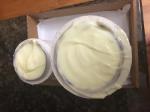Questions About Lye
by Royal Patra
(US, AR)
I am new to soap making, and have ordered two pounds of beaded lye.
After reading about all the dangers of lye I'm kind of freaking out. I literally feel like after I add lye to my liquid... I might run and dive and duck for cover!
I want to make a Milk & Honey recipe using regular whole milk, however, I can't find any recipes that included beaded lye. Is it okay to use still?
I plan to freeze the milk in cubes and add the beads a little at a time.
After seeing footage of Sodium Hydroxide melting through chicken in a matter of seconds I am beyond scared straight, and will not be attempting this without heavy duty equipment.
I literally was about to talk myself out of soap making due to the crazy things I have read. Please help!!!!
My first question is: Where can I store the lye? It says it is in a HDPE container with a child safety cap. I am concerned about moisture getting into the lye.
My next question is since I've never made soap, in your experience after mixing the lye with a water or liquid did you need to step away, or move the container to a distance?
My last question will be: Does the lye bubble up or shoot out of the container? I have seen many people mixing lye into a solution right next to the bowl as if making cookies. I do not want to put me or my family at risk.
Hopefully some answers will ease my nerves about soap making!
Lastly:If I happen to spill some will it burn through the counter/table? Like acid does in the movies.
I was informed on another website by a chemist that I should dilute lye with plain water first. Then neutralize with vinegar afterwards.
Your help is much appreciated! Hopefully I don't have to re-enact a movie scene where the character jumps right before the explosion.
Lord willing I will make my first batch of soap with no problems!
Answer:
My first suggestion is to read my page on Sodium Hydroxide.
Now I will try to run through the questions as you've asked them above.
"Lye beads" is just another name for "lye pellets" and are perfectly fine to use.
Recipes will not refer to the form of the lye you are using unless the recipe calls for liquid lye. All the recipes on this site can be made using lye beads, pellets, or flakes. I like to use beads myself as they dissolve quickly and are easy to measure in small amounts.
Since you are a new soap maker, I do not suggest making a milk and honey soap as your first batch. Both of those ingredients are best left until you have made soap a few times as they are harder to work with.
Make a simple soap that has little to no extra additives. This will give you a feel for how the basic soap is supposed to behave when making it.
I'm sure that a strong lye solution
Yes, you do want to wear long sleeves, gloves and eye protection when working with the lye solution.
The lye can be stored in the container it is coming in. An HDPE container with a child safety cap is perfect. Keep it in a location that is dry and away fromm humidity. If the container is small enough, you can always place it into a zip-lock bag for extra protection.
When mixing the lye solution, it is best to do so in a ventilated area. Turning on an oven fan or opening a window are usually enough.
When I mix my lye, I carefully pour the lye beads into the water, give a couple of stirs and walk away for a couple of minutes. This gives the fumes time to disburse.
I have never had my lye solution shoot out of the container as I was making it in the almost 20 years of making soap...thank goodness!
Always pour the lye beads into the water and NEVER pour the water into the lye beads. I believe that is when you can encounter those scary situations.
When making your soap, I strongly suggest protecting your surfaces with plastic or vinyl tablecloths...I use one of those picnic type you can buy at a dollar store.
If you poured the lye solution onto your counter, it could damage it, especially if you left it and did not clean it up right away. It will not however, be like you see in the movies. Your counter will not melt right before your eyes.
Remember that if you were to pour straight bleach on your counter, it too could cause damage. Bleach is also a caustic substance yet people use it every day. You certainly wouldn't want to stick your hand in straight bleach.
Simple steps can be taken to make the experience less frightening. Mix your lye solution up in the kitchen sink. If it spills, it goes down the drain and you just turn the cold water tap on to dilute it as it goes.
Have your oils set up next to the sink so you are not travelling with the lye solution. Have everything ready and in easy reach.
If you do splash some lye on your skin, you should run cold water on the area until it is gone. Vinegar is no longer considered necessary but I do not believe it would hurt.
Lastly, I am happy to inform you that you will not need to jump through the window while your kitchen explodes! Certainly not from making cold process soap.
Keep the first few batches super simple. This will give you less to worry about while you become comfortable working with lye. Before you know it, making soap will become second nature and you'll become as addicted to making it as the rest of us!
Good luck and happy soaping,
Cathy Winsby

